News
Links to the Original Descriptions of Early Treehopper Family-Group Taxa (1758 to 1928)
2024-07-13
The following bibliographic links were compiled for incorporation into the Family-Group Taxon pages of the Treehoppers Website. Only the original descriptions of higher treehopper taxa published through 1928 are included here (works published before 1929 are now in the public domain). Familiar family-group taxa include the ranks family, subfamily, and tribe, but some early higher category ranks (listed in italics in the header, below) are no longer in general use. Prior to 1929, a total of 51 family-group names had been proposed in the classification of treehoppers, including the current families Membracidae Rafinesque, 1815 (as “Membracidia”), and Aetalionidae Spinola, 1850 (as “Aethalionoideae” [sic]). The references are arranged chronologically by their Metcalf reference identifier. The online bibliographic database DrMetcalf provides expanded literature citations for these identifiers. Metcalf’s copy of Spinola 1850a is paged 1-60, with “Aethalionideae” on p. 53; other copies of this work are paged differently (link below), with “Aethalionideae” on p. 93. Higher taxa names proposed within each reference are arranged alphabetically. All 51 of the early family-group names herein first appeared in just 12 works, published between 1766 and 1926, which form the foundation of modern treehopper classification. For many of some 29 early higher taxa still considered to be valid, subsequent publications may include more complete, or even fully revised, descriptions (see Selected References on our Treehoppers taxon pages). Increased understanding of phylogenetic relationships will forever lead to improved higher classifications.
Reference (Metcalf identifier) Taxon Rank [D = Division, F = Family; Gr = Group, Q = Quadivision, R = Race, S = Subfamily, T = tribe] Taxon Status (if not valid) [h = junior homonym; s = junior synonym; n = unavailable (nomen nudum); u = unavailable (other)] Taxon Name.
1 Houttuyn 1766a: F n Foliaceae, p. 254. 2 Beckmann 1772a: Gr n Cruciatae, p. 150. 3 Rafinesque 1815a; F Membracidae, p. 121; S Membracinae, p. 121; T Membracini, p. 121. 4 Amyot and Serville 1843a: Gr u Bocydides, p. 551; T Centotini, p. 549; S Centrotinae, p. 549; T Centrotini, p. 549; Gr s Combophorides, p. 546; T n Cornidorsi, p. 532; S Darninae, p. 544; T Darnini, p. 544; Gr u Hoplophorides, p. 537; R n Nudiscuti, p. 549; R n Tectiscuti, p. 532. 5 Agassiz, Erichson, and Germar 1846a: Q n Nudiscuti, p. 9. 6 Spinola 1850a: F Aetalionidae, p. 93 [or p. 53]; S Aetalioninae, p. 93 [or p. 53]; T Aetalionini, p. 93 [or p. 53]. 7 Stål 1866a: S Smiliinae, p. 83; T Smiliini, p. 83; S s Tragopinae, p. 83; T Tragopini, p. 83. 8 Goding 1892a: T Aconophorini, p. 225; T Boocerini, p. 254; T Ceresini, p. 256; T s Heniconotini, p. 256; T Polyglyptini, p. 257; T Telamonini, p. 258. 9 Fowler 1895c: T Acutalini, p. 87; T s Cyphoniini, p. 87. 10 Distant 1908g: D s Acanthophyesaria, p. 24; T s Coccosterphini, p. 59; T Gargarini, p. 45; T Hypsaucheniini, p. 10; T Leptocentrini, p. 27; T Micreunini, p. 14; S s Oxyrhachinae, p. 3; T Oxyrhachini, p. 3. 11 Ball 1915b: S s Stictocephalinae, p. 367. 12 Goding 1926e: T n Acuminatini, p. 297; T Amastrini, p. 312; T s Bolbonotini, p. 303; T n Hebesini, p. 300; T s Hemiptychini, p. 308; S Heteronotinae, p. 310; T Heteronotini, p. 310; S s Hoplophorioninae, p. 295; T Hoplophorionini, p. 295; T s Potniini, p. 305; T s Pterygiini, p. 303.
Prepared by Lewis L. Deitz (12 July 2024)
Reference (Metcalf identifier) Taxon Rank [D = Division, F = Family; Gr = Group, Q = Quadivision, R = Race, S = Subfamily, T = tribe] Taxon Status (if not valid) [h = junior homonym; s = junior synonym; n = unavailable (nomen nudum); u = unavailable (other)] Taxon Name.
1 Houttuyn 1766a: F n Foliaceae, p. 254. 2 Beckmann 1772a: Gr n Cruciatae, p. 150. 3 Rafinesque 1815a; F Membracidae, p. 121; S Membracinae, p. 121; T Membracini, p. 121. 4 Amyot and Serville 1843a: Gr u Bocydides, p. 551; T Centotini, p. 549; S Centrotinae, p. 549; T Centrotini, p. 549; Gr s Combophorides, p. 546; T n Cornidorsi, p. 532; S Darninae, p. 544; T Darnini, p. 544; Gr u Hoplophorides, p. 537; R n Nudiscuti, p. 549; R n Tectiscuti, p. 532. 5 Agassiz, Erichson, and Germar 1846a: Q n Nudiscuti, p. 9. 6 Spinola 1850a: F Aetalionidae, p. 93 [or p. 53]; S Aetalioninae, p. 93 [or p. 53]; T Aetalionini, p. 93 [or p. 53]. 7 Stål 1866a: S Smiliinae, p. 83; T Smiliini, p. 83; S s Tragopinae, p. 83; T Tragopini, p. 83. 8 Goding 1892a: T Aconophorini, p. 225; T Boocerini, p. 254; T Ceresini, p. 256; T s Heniconotini, p. 256; T Polyglyptini, p. 257; T Telamonini, p. 258. 9 Fowler 1895c: T Acutalini, p. 87; T s Cyphoniini, p. 87. 10 Distant 1908g: D s Acanthophyesaria, p. 24; T s Coccosterphini, p. 59; T Gargarini, p. 45; T Hypsaucheniini, p. 10; T Leptocentrini, p. 27; T Micreunini, p. 14; S s Oxyrhachinae, p. 3; T Oxyrhachini, p. 3. 11 Ball 1915b: S s Stictocephalinae, p. 367. 12 Goding 1926e: T n Acuminatini, p. 297; T Amastrini, p. 312; T s Bolbonotini, p. 303; T n Hebesini, p. 300; T s Hemiptychini, p. 308; S Heteronotinae, p. 310; T Heteronotini, p. 310; S s Hoplophorioninae, p. 295; T Hoplophorionini, p. 295; T s Potniini, p. 305; T s Pterygiini, p. 303.
Prepared by Lewis L. Deitz (12 July 2024)
French Guiana Treehopper Update from Jérémie Lapèze
2024-07-12
We are grateful to Jérémie Lapèze, a longtime collaborator of the Treehoppers Team (see archive of past news: 2018-02-05; 2020-07-14; 2021-05-11; 2022-08-13; 2022-11-07), for sharing an update on his contributions on the treehoppers of French Guiana. In 2021, Jérémie released the third version of his online publication "Guide Illustré des Membracides de Guyane" (Lapèze 2021a). This beautifully illustrated guide to the treehoppers of French Guiana is in French, as are the following works that describe new treehopper species in various genera from French Guiana:
Lapèze, J.; Lopez-Vaamonde, C. 2022a. Trois nouvelles espèces de Lycoderides Sakakibara, 1972 (Hemiptera: Membracidae: Stegaspidinae) de Guyane Française ayant pour plante-hôte des Clusia (Clusiaceae). Faunitaxys 10(7): 1-19. [Available online. Unlike the two works below, this publication was not previously listed in the “Treehoppers” news. It includes descriptions of three new species of Lycoderides: L. carboneus, L. elephantus, and L. phi, all described by Lapèze in Lapèze and Lopez-Vaamonde.]
Lapèze, J. 2022a. Le genre Centronodus Funkhouser (Hemiptera : Membracidae : Centronodinae) en Guyane française et description d'une nouvelle espèce. Faunitaxys 10(37): 1-9. [Available online.]
Lapèze, J. 2022b. Un nouveau membracide inféodé aux forêts de nuages: Cymbomorpha nebulosilvensis n. sp. (Hemiptera; Auchenorrhyncha; Membracidae). Faunitaxys 10(51): 1-6. [Available online.]
Lapèze, J.; Lopez-Vaamonde C. 2024a. Description de cinq nouvelles espèces de Lycoderides Sakakibara (Hemiptera: Auchenorrhyncha: Membracidae) de Guyane française. Faunitaxys 12(3): 1-23. [Available online this new publication includes descriptions of 5 new species of Lycoderides: L. flucticulus, L. labyrinthicus (Figs. 1-2), L. malicornus (Figs. 2-3), L. minutifloraphiles, and L. phi, all described by Lapèze in Lapèze and Lopez-Vaamonde.]
Figs. 1-4. 1-2, Lycoderides labyrinthicus (1, female. 2, the pale green nymph only; also Amastrini nymphs with attending ants). 3-4. L. malicornus (3, male. 4, female, on Vismia maripasoula). Images Copyright © 2024, by Jérémie Lapèze.
1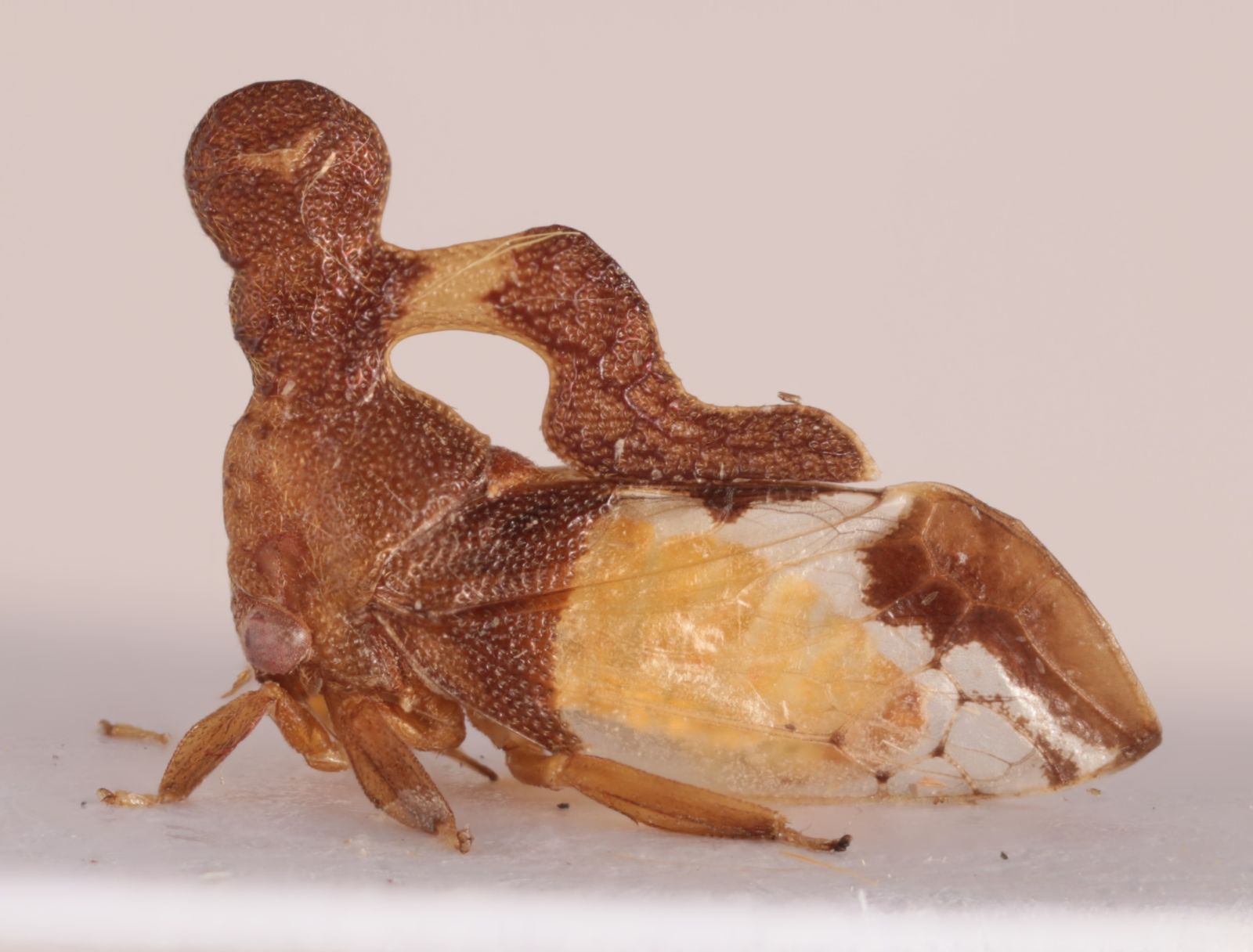 2
2 
3 4
4 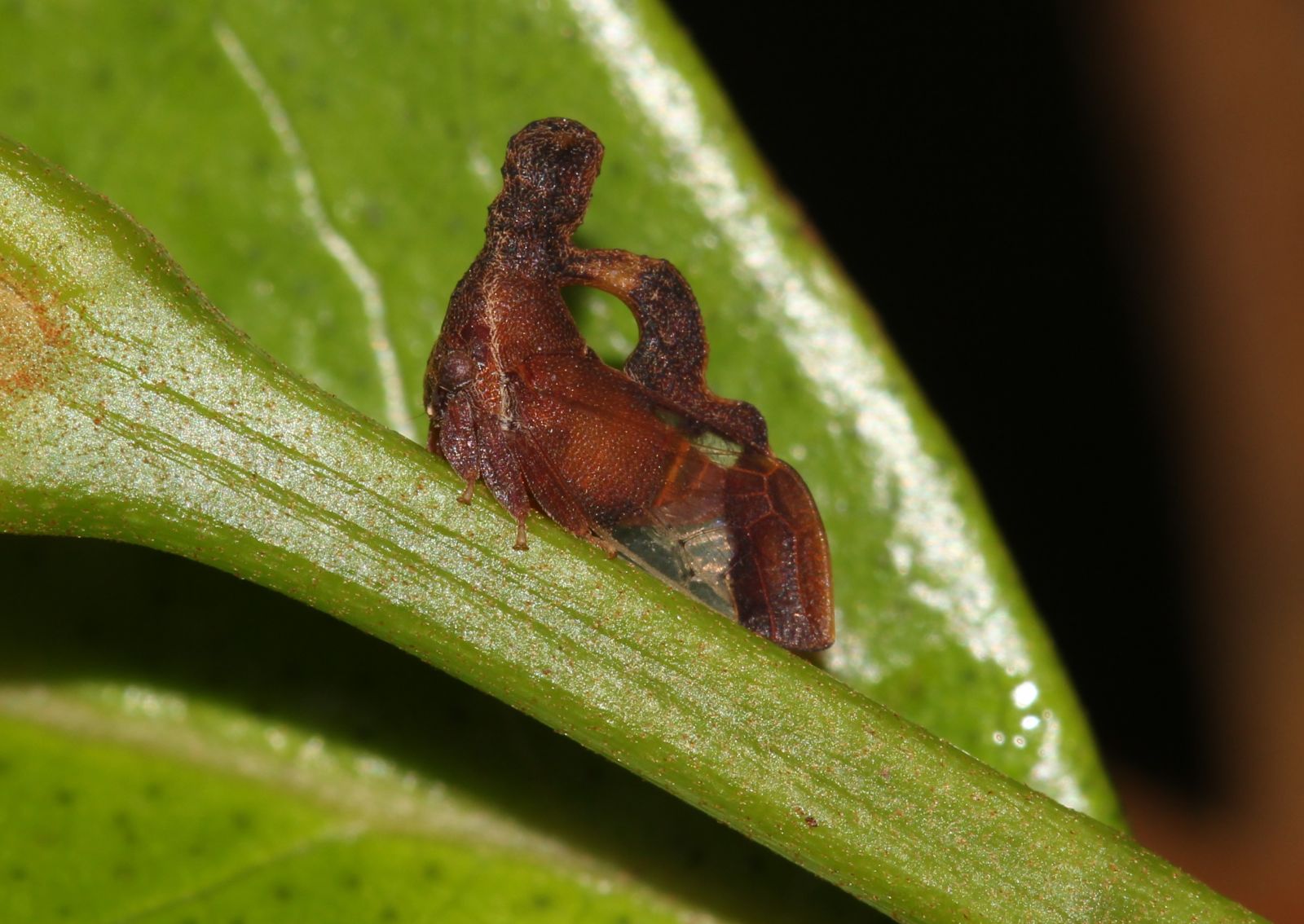
Jérémie also tells us: “Now I am working on a checklist of Membracidae and Aetalionidae of French Guiana” as well as a paper on associations between treehoppers, their host plants, and ants. His future projects may include describing new species in the genera Cyphonia and Tolania from French Guiana.
Lapèze, J.; Lopez-Vaamonde, C. 2022a. Trois nouvelles espèces de Lycoderides Sakakibara, 1972 (Hemiptera: Membracidae: Stegaspidinae) de Guyane Française ayant pour plante-hôte des Clusia (Clusiaceae). Faunitaxys 10(7): 1-19. [Available online. Unlike the two works below, this publication was not previously listed in the “Treehoppers” news. It includes descriptions of three new species of Lycoderides: L. carboneus, L. elephantus, and L. phi, all described by Lapèze in Lapèze and Lopez-Vaamonde.]
Lapèze, J. 2022a. Le genre Centronodus Funkhouser (Hemiptera : Membracidae : Centronodinae) en Guyane française et description d'une nouvelle espèce. Faunitaxys 10(37): 1-9. [Available online.]
Lapèze, J. 2022b. Un nouveau membracide inféodé aux forêts de nuages: Cymbomorpha nebulosilvensis n. sp. (Hemiptera; Auchenorrhyncha; Membracidae). Faunitaxys 10(51): 1-6. [Available online.]
Lapèze, J.; Lopez-Vaamonde C. 2024a. Description de cinq nouvelles espèces de Lycoderides Sakakibara (Hemiptera: Auchenorrhyncha: Membracidae) de Guyane française. Faunitaxys 12(3): 1-23. [Available online this new publication includes descriptions of 5 new species of Lycoderides: L. flucticulus, L. labyrinthicus (Figs. 1-2), L. malicornus (Figs. 2-3), L. minutifloraphiles, and L. phi, all described by Lapèze in Lapèze and Lopez-Vaamonde.]
Figs. 1-4. 1-2, Lycoderides labyrinthicus (1, female. 2, the pale green nymph only; also Amastrini nymphs with attending ants). 3-4. L. malicornus (3, male. 4, female, on Vismia maripasoula). Images Copyright © 2024, by Jérémie Lapèze.
1
 2
2 
3
 4
4 
Jérémie also tells us: “Now I am working on a checklist of Membracidae and Aetalionidae of French Guiana” as well as a paper on associations between treehoppers, their host plants, and ants. His future projects may include describing new species in the genera Cyphonia and Tolania from French Guiana.
Cladonota pelaezi, a Wonderful New Species from Guatemala
2024-07-11
Flynn, D. J. [2024b (dated 2023)]. A new treehopper species of Cladonota (Stål) from Guatemala (Hemiptera: Membracinae: Hypsoprorini) and errata on prior Cladonota publications. Proceedings of the Entomological Society Washington 125(4): 465-479. [Available online: doi.org/10.4289/0013-8797.125.4.465; link has a “paywall”.]
This work describes the terrific new species Cladonota (Lecythifera) pelaezi (Fig. 1). Although dated 2023, the paper’s actual date of publication is 1 July 2024.
Fig. 1. Cladonota (Lecythifera) pelaezi, Santa Catarina Pinula, Guatemala. Image Copyright © 2021, by Grete Pasch, iNaturalist Guatemala.
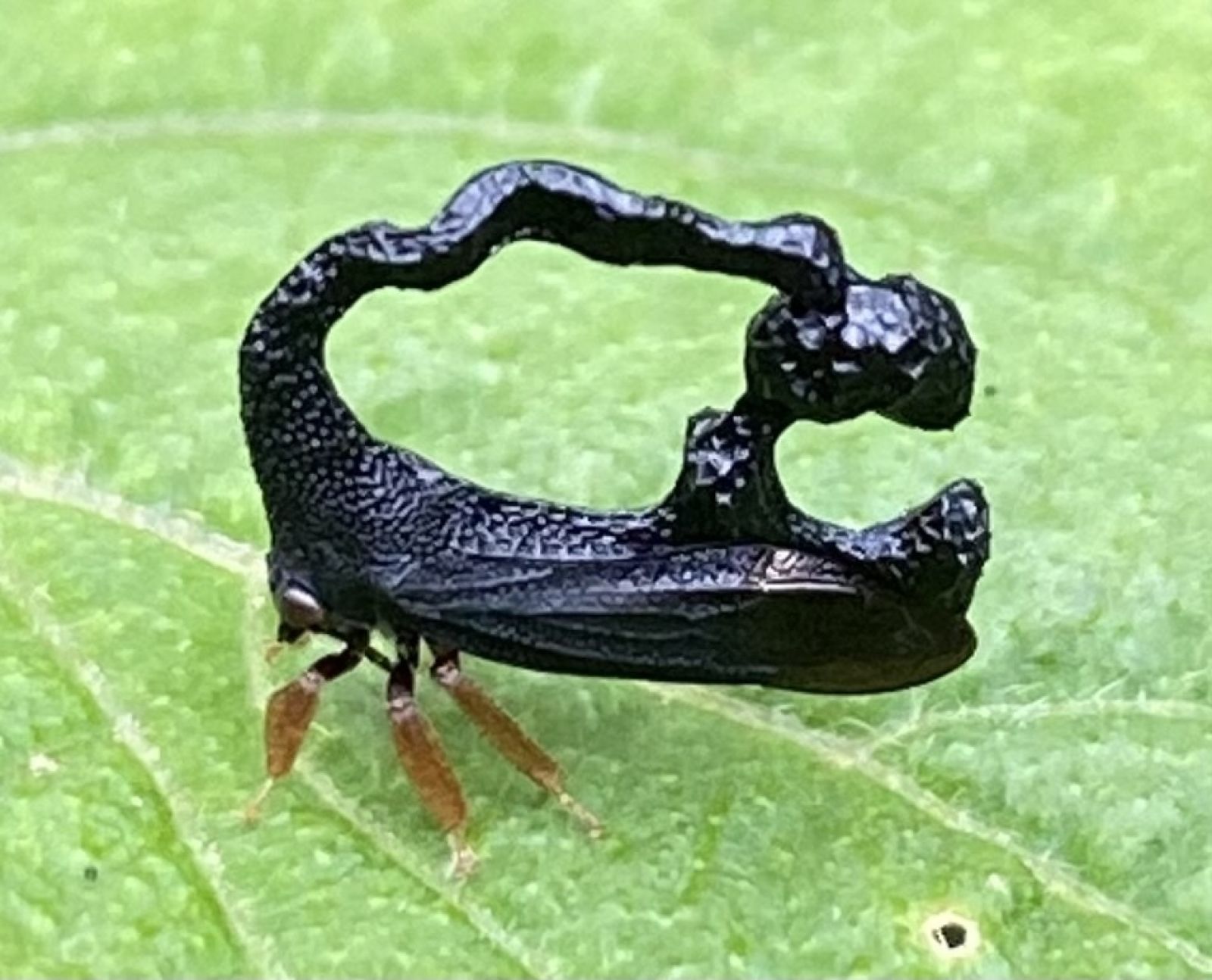
Team Treehoppers welcomes Grete Pasch (Laguna del Bosque, Guatemala) as a new collaborator for allowing us to share this great live shot of C. pelaezi.
This work describes the terrific new species Cladonota (Lecythifera) pelaezi (Fig. 1). Although dated 2023, the paper’s actual date of publication is 1 July 2024.
Fig. 1. Cladonota (Lecythifera) pelaezi, Santa Catarina Pinula, Guatemala. Image Copyright © 2021, by Grete Pasch, iNaturalist Guatemala.

Team Treehoppers welcomes Grete Pasch (Laguna del Bosque, Guatemala) as a new collaborator for allowing us to share this great live shot of C. pelaezi.
Frederic Webster Goding: Treehoppers Were “His Hobby and Recreation”
2024-07-02
Figs. 1-3. 1-2, “Sr. Dr. Frederico W. Goding, Consul General de los Estados Unidos y distinguido Naturalista” (images reproduced from: Frontispiece in 1920, Revista del Colegio Nacional Vicente Rocafuerte 5:1. NOT_UNDER_COPYRIGHT). 3, Godingia, a monotypic genus named in honor of F. W. Goding by W. W. Fowler (photo of G. guerreroensis Fowler, © Copyright 2010, by Matthew S. Wallace).
1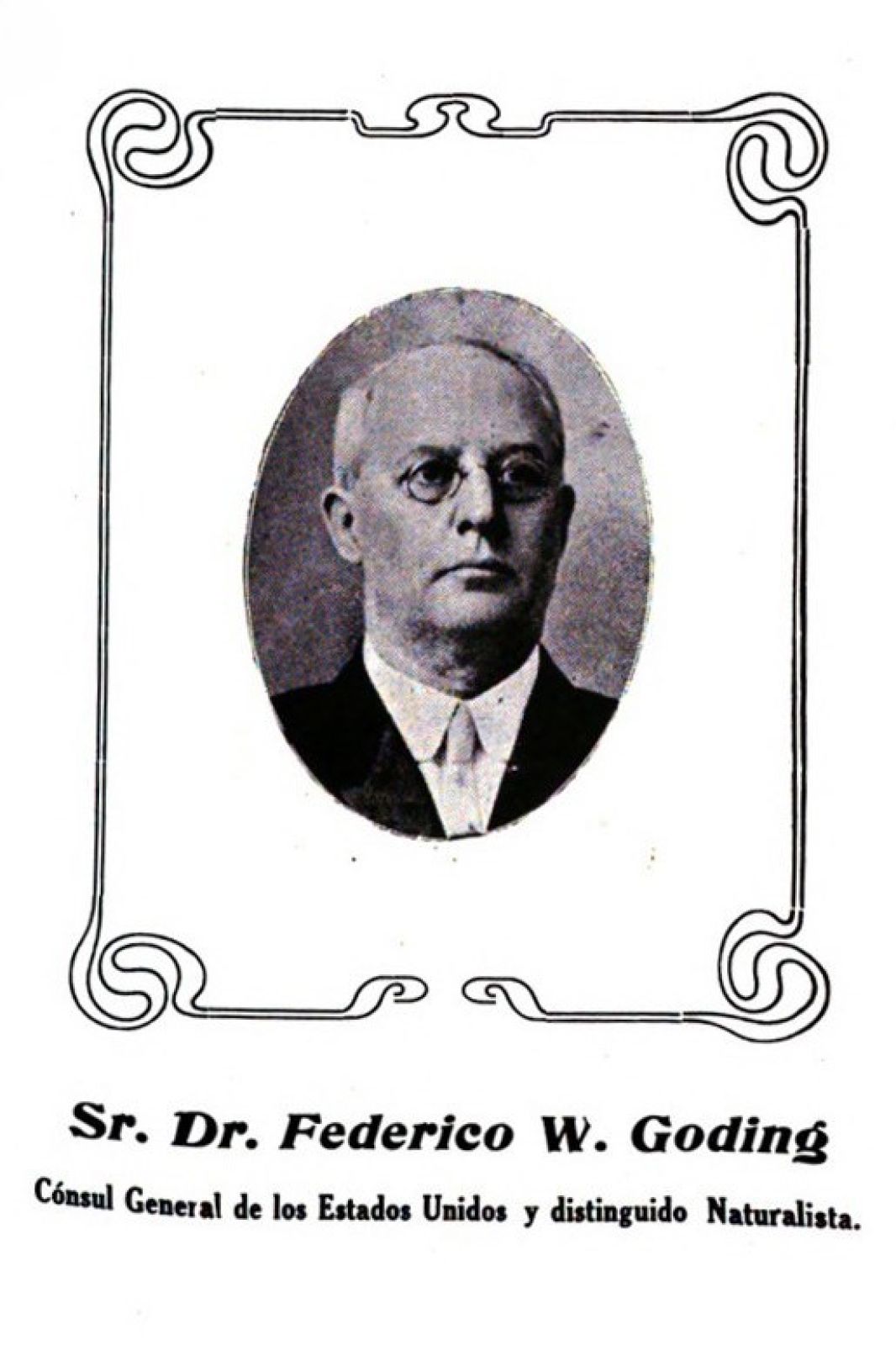 2
2  3
3 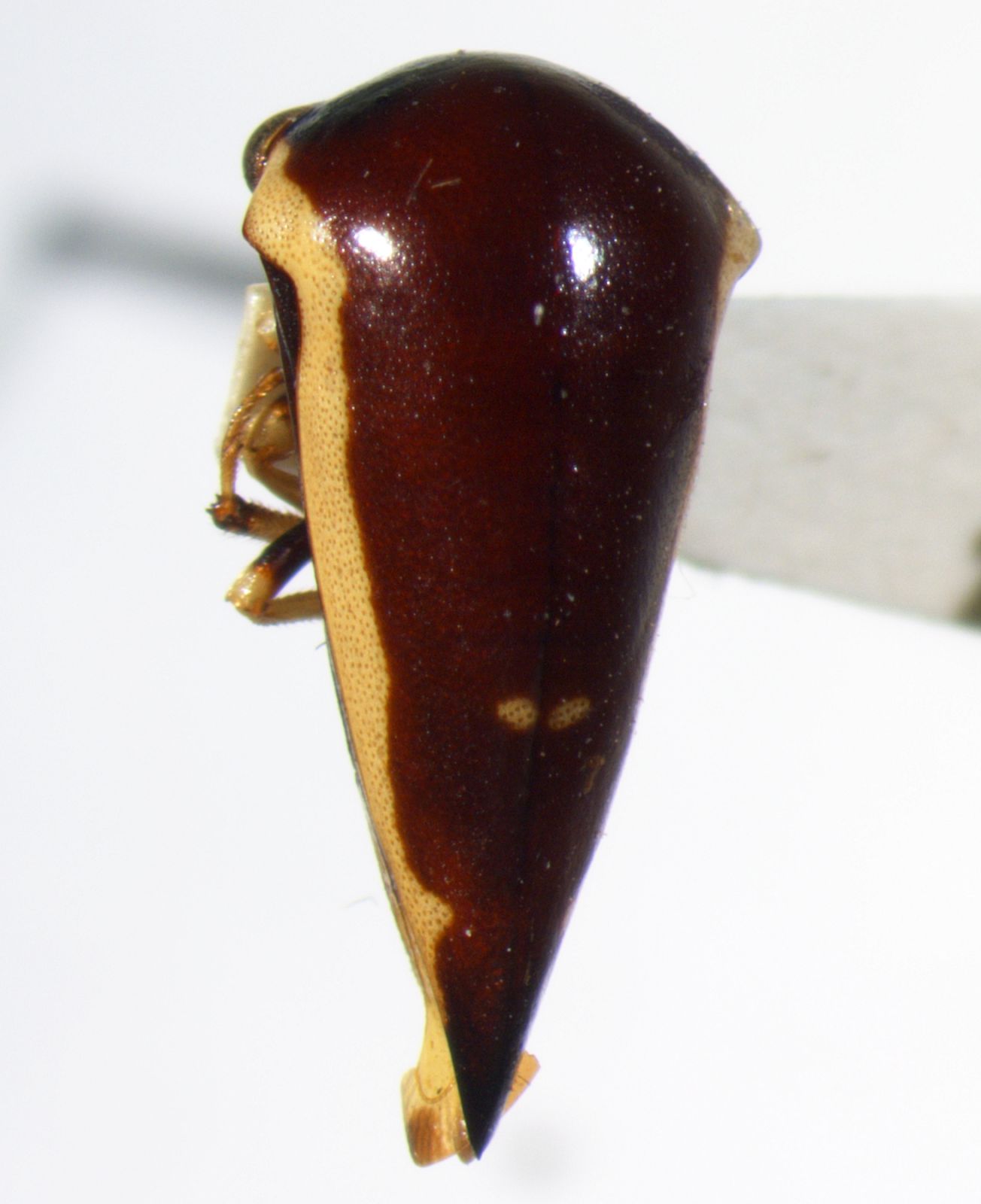
We recognize Dr. Frederic W. Goding (9 May 1858 - 5 May 1933) as a leading specialist on treehoppers (Olsen 1934a: Goding’s obituary and bibliography), but he was also an American diplomat, physician, and inventor. Born in Boston, Massachusetts, Goding’s early entomological career included positions as the Assistant State Entomologist of Illinois (1883-1885) and as chair of Natural Sciences at Louden College in Tennessee (1885-86). Later, working as an American diplomat, he was initially stationed in Australia (1898), and subsequently in Uruguay, and Ecuador. During this service abroad (nearly 30 years), “membracid taxonomy was his hobby and recreation” (Olsen 1934). This consuming hobby resulted in Goding’s astonishing contributions to our knowledge of treehoppers, including the proposal of more than 250 new taxa: 2 subfamilies (Heteronotinae remains valid), 21 tribes (11 valid), 39 genera (23 valid), 2 subgenera (1 valid), 189 species (120 valid), and 10 subspecies (all valid).
The list of Goding’s valid treehopper genera is impressive in its taxonomic and geographic scope: Ashmeadea, Biturritia, Centrodontus, Cryptoparma, Cyrtolobus, Dingkana, Eufrenchia, Eutryonia, Euwalkeria, Evanchon, Flexocentrus, Guayaquila, Lubra, Marshallella, Membracidoidea, Mendicea, Metcalfiella, Multareis, Paragara, Paraxiphopoeus, Quadrinarea, Tumecauda, and Vanduzea.
Online links to all of Goding’s 54 publications on treehoppers, except Goding 1921b (marked “NEEDED”), are listed below, based on Z. P. Metcalf’s unique identifiers. The link to Goding 1927c has a “paywall”. Detailed citations of all of Goding’s works on Auchenorrhyncha may be generated using the search page of the DrMetcalf database.
Goding 1892a, Goding 1892b, Goding 1892c, Goding1892d, Goding 1893a, Goding 1893b, Goding 1893c, Goding 1893d, Goding 1893e, Goding 1895a, Goding 1897a, Goding 1898a, Goding 1903a, Goding 1914a, Goding 1920a, Goding 1920b, Goding 1920c,Goding 1921a, Goding 1921b [NEEDED: Boletin de Medicina y Cirugia (Guayaquil) 18:31-37], Goding 1925b, Goding 1926a, Goding 1926c, Goding 1926d, Goding 1926e, Goding 1926f, Goding 1927a, Goding 1927b, Goding 1927c [paywall], Goding 1928a, Goding 1928b, Goding 1928c, Goding 1928d, Goding 1928e, Goding 1929a, Goding 1929b, Goding 1929c, Goding 1929d, Goding 1929e, Goding 1930a, Goding 1930b, Goding 1930c, Goding 1930d, Goding 1931a, Goding 1931b, Goding 1931c, Goding 1932a, Goding 1933a, Goding 1934a, Goding 1939a, Goding 1949a, Goding 1949b, Goding 1950a, Goding 1951a, Goding and Froggatt 1904a ["Membracidae" in key to families, p. 563].
Please contact Lewis Deitz if you become aware of additional publications by F. W. Goding on treehoppers or if you locate the needed Goding 1921b link or a non-paywall link for Goding 1927f. Meanwhile, enjoy these additions to your digital treehopper library.
Footnote: Treehopper specialist Stuart McKamey tells us he has an interesting connection to Goding that largely funded Stu’s undergraduate studies at Berkeley. In McKamey’s words: “After my grandfather Henry Brandon died, I had the opportunity to review some of his paperwork. Among them was his business license for making Panama hats (which are made in Cuenca, Ecuador). What immediately caught my attention was the Goding-esque script at the bottom of the page.” Lo and behold, it was Frederick Goding himself, while serving as U.S. General Council in Ecuador, who had approved the license for Henry to start his lucrative Panama hat factory in Cuenca, where all true Panama Hats are made. Coincidentally, Dr. McKamey currently studies treehoppers and leafhoppers at the USNM, steps away from where many of Goding’s treehopper types are housed.
1
 2
2  3
3 
We recognize Dr. Frederic W. Goding (9 May 1858 - 5 May 1933) as a leading specialist on treehoppers (Olsen 1934a: Goding’s obituary and bibliography), but he was also an American diplomat, physician, and inventor. Born in Boston, Massachusetts, Goding’s early entomological career included positions as the Assistant State Entomologist of Illinois (1883-1885) and as chair of Natural Sciences at Louden College in Tennessee (1885-86). Later, working as an American diplomat, he was initially stationed in Australia (1898), and subsequently in Uruguay, and Ecuador. During this service abroad (nearly 30 years), “membracid taxonomy was his hobby and recreation” (Olsen 1934). This consuming hobby resulted in Goding’s astonishing contributions to our knowledge of treehoppers, including the proposal of more than 250 new taxa: 2 subfamilies (Heteronotinae remains valid), 21 tribes (11 valid), 39 genera (23 valid), 2 subgenera (1 valid), 189 species (120 valid), and 10 subspecies (all valid).
The list of Goding’s valid treehopper genera is impressive in its taxonomic and geographic scope: Ashmeadea, Biturritia, Centrodontus, Cryptoparma, Cyrtolobus, Dingkana, Eufrenchia, Eutryonia, Euwalkeria, Evanchon, Flexocentrus, Guayaquila, Lubra, Marshallella, Membracidoidea, Mendicea, Metcalfiella, Multareis, Paragara, Paraxiphopoeus, Quadrinarea, Tumecauda, and Vanduzea.
Online links to all of Goding’s 54 publications on treehoppers, except Goding 1921b (marked “NEEDED”), are listed below, based on Z. P. Metcalf’s unique identifiers. The link to Goding 1927c has a “paywall”. Detailed citations of all of Goding’s works on Auchenorrhyncha may be generated using the search page of the DrMetcalf database.
Goding 1892a, Goding 1892b, Goding 1892c, Goding1892d, Goding 1893a, Goding 1893b, Goding 1893c, Goding 1893d, Goding 1893e, Goding 1895a, Goding 1897a, Goding 1898a, Goding 1903a, Goding 1914a, Goding 1920a, Goding 1920b, Goding 1920c,Goding 1921a, Goding 1921b [NEEDED: Boletin de Medicina y Cirugia (Guayaquil) 18:31-37], Goding 1925b, Goding 1926a, Goding 1926c, Goding 1926d, Goding 1926e, Goding 1926f, Goding 1927a, Goding 1927b, Goding 1927c [paywall], Goding 1928a, Goding 1928b, Goding 1928c, Goding 1928d, Goding 1928e, Goding 1929a, Goding 1929b, Goding 1929c, Goding 1929d, Goding 1929e, Goding 1930a, Goding 1930b, Goding 1930c, Goding 1930d, Goding 1931a, Goding 1931b, Goding 1931c, Goding 1932a, Goding 1933a, Goding 1934a, Goding 1939a, Goding 1949a, Goding 1949b, Goding 1950a, Goding 1951a, Goding and Froggatt 1904a ["Membracidae" in key to families, p. 563].
Please contact Lewis Deitz if you become aware of additional publications by F. W. Goding on treehoppers or if you locate the needed Goding 1921b link or a non-paywall link for Goding 1927f. Meanwhile, enjoy these additions to your digital treehopper library.
Footnote: Treehopper specialist Stuart McKamey tells us he has an interesting connection to Goding that largely funded Stu’s undergraduate studies at Berkeley. In McKamey’s words: “After my grandfather Henry Brandon died, I had the opportunity to review some of his paperwork. Among them was his business license for making Panama hats (which are made in Cuenca, Ecuador). What immediately caught my attention was the Goding-esque script at the bottom of the page.” Lo and behold, it was Frederick Goding himself, while serving as U.S. General Council in Ecuador, who had approved the license for Henry to start his lucrative Panama hat factory in Cuenca, where all true Panama Hats are made. Coincidentally, Dr. McKamey currently studies treehoppers and leafhoppers at the USNM, steps away from where many of Goding’s treehopper types are housed.

